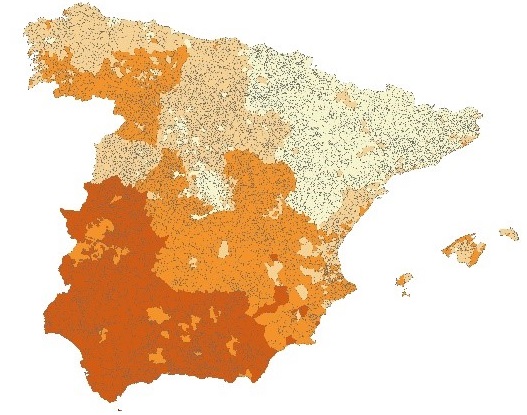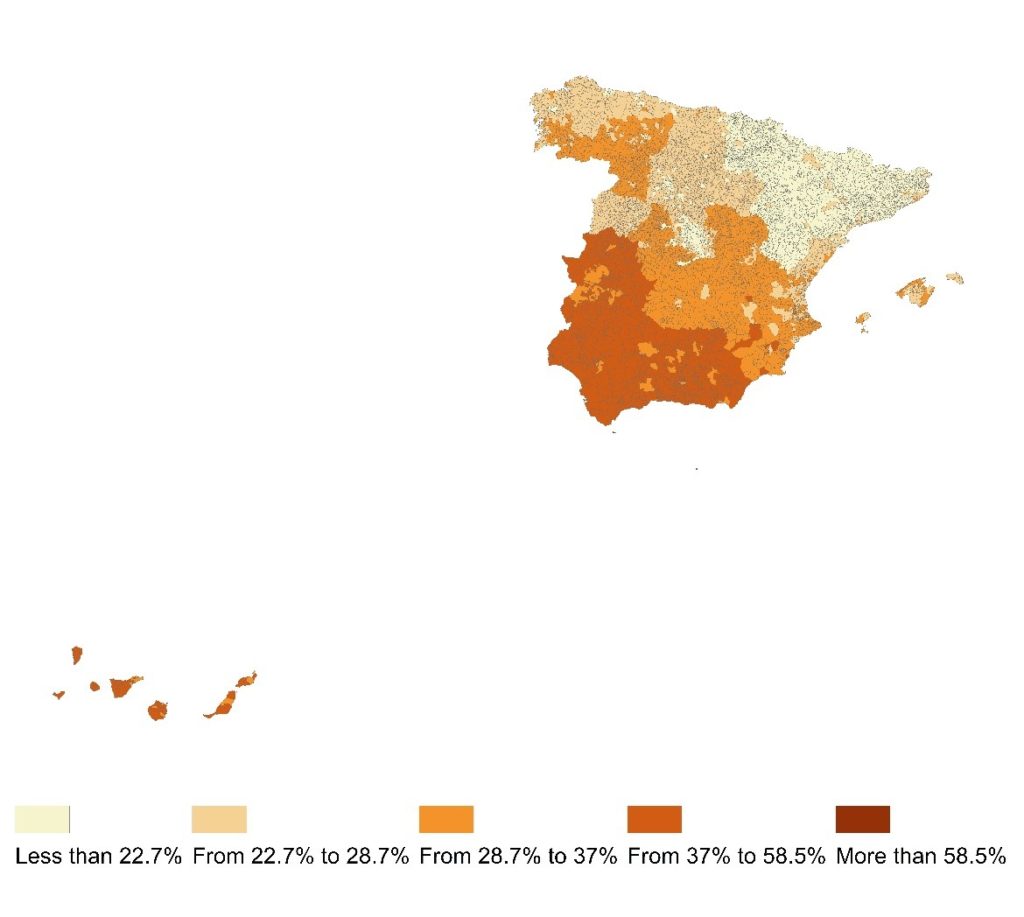The question of the most appropriate method for measuring poverty has always been complex and a source of broad debate among economists. The statistical office of the European Union, EUROSTAT, offers an indicator of the proportion of people at risk of poverty or social exclusion known by the acronym AROPE. This indicator derives from the need to adopt a multidimensional concept of social exclusion and the need to offer a single indicator that incorporates not only low-income populations but also aspects of vulnerability, exclusion or relative deprivation. According to the AROPE criteria, a person is at risk of poverty or social exclusion if at least one of the following three criteria is met:
- Lives in a household with an income (including social transfers) below the poverty line, which is defined as an income that is 60% of the median of the national income’s equivalent in consumption units[1].
- Lives in a household where its members cannot afford at least four of the nine basic consumption needs defined for Europe[2].
- Lives in a household with low work intensity. The intensity of work is defined as the ratio between the number of months actually worked by all the members of the household and the maximum number of months that all people of working age in the household could theoretically work. Households that are considered to have low work intensity are those with a ratio of less than 0.2.
Despite the fact that AROPE is a big step forward in the analysis of poverty insofar as it provides an indicator that is based on a multidimensional concept and is comparable across countries, regions and time, in Europe this indicator is only available for NUTS 2 regions. In Spain, NUTS2 regions correspond to Autonomous Communities, a very extensive geographic area that contains many different socio-economic landscapes. Is the incidence of poverty higher in cities or in rural areas? What about the tourist-based coastal areas in comparison to the inland areas of the same NUTS2 region? What about the more isolated (peripheral) areas in comparison to the ones better-connected to the economic centre of the region?
AROPE figures at regional level do not allow us to analyse what is happening at a smaller spatial scale, e.g., counties, municipalities or neighbourhoods.
Using econometric techniques[3] to disaggregate official AROPE figures for NUTS 2 regions into smaller spatial units, the IMAJINE Project provides AROPE figures at local level (LAU2 or municipalities in the Spanish case). The statistical resources necessary to implement the methodology only permits us to obtain estimations for the year 2011, which is the year of the last Population and Housing Census available for many EU countries.
AROPE figures for 2011 for NUTS 2 regions (Autonomous Communities) are shown in Map 1 and for LAU2 (municipalities) in Map 2
Map 1. Percentage of Population at Risk of Poverty and Exclusion (AROPE) for NUTS2 regions in Spain (2011) (Source: own elaboration from IMAJINE Project estimations)
Map 2. Percentage of Population at Risk of Poverty and Exclusion (AROPE) for LAU2 in Spain (2011) (Source: own elaboration from IMAJINE Project estimations)
The expected spatial patterns of poverty are illustrated: there exists a higher level of poverty (measured with the AROPE indicator) in the southwest of the Spanish territory, primarily in the Autonomous Communities of Andalusia and Extremadura (in addition to the Canary Islands). In these NUTS2 regions there are many municipalities with more than 25% of their populations, and sometimes more than 40%, at risk of poverty. The percentage of population at risk of poverty in the Northeast is clearly lower, below 22% in most municipalities. However, there are some very specific areas/municipalities in which the values are similar to those present in the South and Southwest. It is especially interesting to observe the higher values of AROPE in the areas surrounding Barcelona city. We can also detect high AROPE values in some municipalities along the Mediterranean coast located in areas that are very specialized in tourism activities with high seasonal dependence.
Ana Viñuela, Fernando Rubiera & Esteban Fernandez (University of Oviedo)
[1] The calculation of the units of consumption takes into account economies of scale in households and is based on the hypothesis that the joint expenditure of several persons residing in the same household is lower than what each would spend living separately.
[2] The nine basic consumption concepts used are (1) late payment of rent, mortgage or utility bills of the primary residence over the last 12 months; (2) inability to keep the home adequately heated; (3) inability to take at least a one-week holiday each year; (4) inability to eat meat or protein at least every two days; (5) not having sufficient money for unforeseen expenses; (6) not having a telephone; (7) not having a color television; (8) not having a washing machine; and (9) not having a car.
[3] See D2.2 of the IMAJINE Project for details



